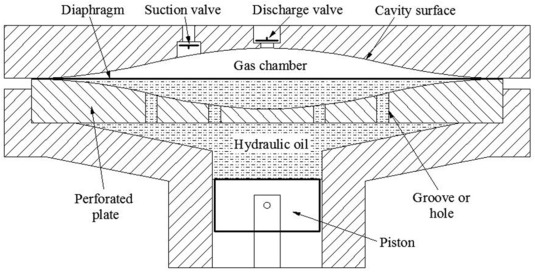
The diaphragm type compressor (also called membrane compressor) is a variant of the reciprocating compressor, and the compression of the gas happens due to the up and down movement of a flexible diaphragm or membrane.
 The up and down movement of the diaphragm is achieved by connecting it with a piston driven by the connection rod and crankshaft. The piston of your diaphragm-type compressor, instead of moving in a cylinder, pulls the diaphragm down (contraction of the diaphragm) to create suction and push the diaphragm up (expansion of the diaphragm) to create discharge. Diaphragm type compressors are used for applications which need contamination and leakage-free process.
The up and down movement of the diaphragm is achieved by connecting it with a piston driven by the connection rod and crankshaft. The piston of your diaphragm-type compressor, instead of moving in a cylinder, pulls the diaphragm down (contraction of the diaphragm) to create suction and push the diaphragm up (expansion of the diaphragm) to create discharge. Diaphragm type compressors are used for applications which need contamination and leakage-free process.
There are several types to consider when it comes to air-ride compressors. The two main types are piston and diaphragm compressors. Piston compressors are the most common type and are usually used in smaller applications. These compressors use a piston to move air into and out of the system, providing a steady flow of air pressure. Diaphragm compressors are more powerful than piston compressors and are typically used in larger applications. They use a diaphragm to move air and provide higher air pressure than piston compressors.
What is the difference between Diaphragm Compressor and Diaphragm Pump?
Posted by phil_h on friday, february 15, 2008 10:19 pm
a dual-piston design is less prone to pulsation in the airflow and can provide a higher, more consitent output pressure compared to a diaphragm type. You will get pulsation in the airflow of a
diaphragm compressor
because by its very nature, (for want of better terms) there is a "compression" (up) stroke and a "return" (down) stroke.
 The diaphragm must return to its starting position and while this happens, it's not pumping air. In a dual piston system, one piston is "compressing" while the other is "returning", so it is able to maintain a consistent output.
The diaphragm must return to its starting position and while this happens, it's not pumping air. In a dual piston system, one piston is "compressing" while the other is "returning", so it is able to maintain a consistent output.
News 1. What is the diaphragm compressor? the diaphragm compressor, also know as membrane compressor, is a popular type of reciprocating compressor. Generally speaking, there are two systems: the hydraulic system used as motive power to control the compression process and the hydraulic system used to compress the air or gas. The essential part of the diaphragm air compressor is the rotary diaphragm,which is controlled by a crankshaft and a connecting rod mechanism powered by the fluid. This diaphragm helps to deliver the air o gas inside the compression chamber and apply the required pressure. For this reason, the membrane or the diaphragm is required to be reliable so that it can bear the pumped gas’s strain.
7) Inlet and Outlet Valves
A diaphragm pump is a type of positive displacement pump consisting of one or more pumping chambers alternately filled and discharged by the movement of a flexible diaphragm with check valves on the inlet and outlet. A simple diaphragm pump is shown in figure 1.
Valve sizing is an important consideration for diaphragm valves intended for throttling applications. The desired volume that will be passing through the valve must be determined, which is affected by flow rate, inlet and outlet temperatures and pressures, specific gravity, and viscosity of the fluid. After obtaining those properties, the valve capacity and pressure drop the diaphragm valve must close against is determined. Several methods are used in valve sizing; using the pipe geometry factor is one of the techniques used in sizing diaphragm valves.
Diaphragm pumps can be either single diaphragm or double diaphragm. As warren describes in the video, a simple explanation of the mechanism of diaphragm pumps is to imagine water cupped in two hands; when the hands squeeze together, the water will fly out. Force is required to operate the diaphragms similarly, and in most cases, air is used to move the diaphragms backwards and forwards. The need for air means that diaphragm pumps require a compressor in addition to the pump itself. The membrane mechanism of pumping requires a series of valves, often a ball in a seat, because as the diaphragm opens, the valve opens to draw product in.
2022-04-06 10:24:09 keepwin a diaphragm compressor adopts a diaphragm plate to isolate the oil and the compress medium gas. So there is no contamination to the medium gas. Which is the best solution to the inflammble and toxic gas. And it is widely used in chemical and petroleum industry. The structure of the diaphragm compressor during the working of the diaphragm compressor, each revolution of the piston delivers a certain amount of hydraulic oil to the membrane or diaphragm. This oil helps the membrane to move upward and downward; due to this movement, the membrane compresses the air or gas. A diaphragm compressor is consist of the next parts.